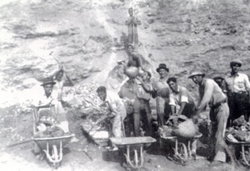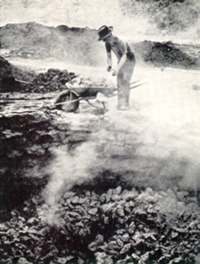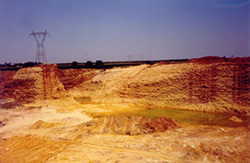

The calcarenites sedimentation took place during the Neogen period, just in the border between Miocene and Pliocene. The constant contribution of materials to the basin and the tectonic activity of the Orógeno Bético (Orogen from southern Spain) cause a change, from a sedimentation on deep means (clays and blue marls) to a platform zone, on superficial conditions where calcarenite is deposited.
The sediment is very coarse, with more than 80% of bivalve fragments and the rest is siliciclastic material, mostly quartz. They are quite bioturbed, with galleries of crustaceans of the Ophiomorfa type over 5 cm. in diameter. They can be also very well stratified, with better classified calcarenite layers and half a grain size alternating with lutitic plates. Structures of internal organizing -grain- are frequent: selection, ripples, undulating lamination... etc, soft pebbles and structures of water leakage. These characteristics make us think about the influence of energetic events, as storms or even seaquakes, in alternation with periods of calm.
The age of these materials can be ascribed to final Messinian- Lower Pliocene (5.5-3.5 Ma). The deposit environment corresponds to a regressive stage where superficial marine platforms are settled, with high energy and constant action of the swell and the presence of coastal bars of platform border. Its position on blue marl favours the slope slides all the Los Alcores area, generally on the joints favour.
Materials similar to albero-sand can be found in many places of the world, since the calcarenites are relatively abundant rocks. Nevertheless, there exist a lot of varieties and the one we call "albero" can be found also in China, at the Yellow River Basin, which was named so after this stone's colour.

Los Alcores' albero-sand has been used since long for building, during the Roman period was used as hydraulic lime and like ashlars, as can be appreciated from the number of stone quarries existing in our district. During the Moorish period, it was used as hydraulic lime and for mud walls. During the Christian period, it was used in ashlars, mud walls and hydraulic lime. Nowadays we use albero-sand, our powdered sun, to carpet paths of parks, fairs and bullfighting rings all over the world; it is taken in ships and covers the far bullrings of Lima, Mexico, etc, making them brighter.
It is also used as road surface because its compacting is optimal, and to make cement that due to this material quality, it is a unique cement in Spain. This is because due to its chemical properties and resistance to sulphates and alkalis, it has become necessary to build in sea water, reservoirs and nuclear power plants. The nuclear residues from El Cabril (Córdoba) are stored in large cans with reinforced concrete made of this cement. However, its most important use in the 20th century has been as hydraulic lime in the limestone quarries of Alcalá and, a little less, in Los Alcores.
At Los Alcores region, from Carmona to Alcalá, hydraulic lime with albero as raw material was manufactured since immemorial times, having the following approximate richness: 80% calcite, 12% quartz, 6% of phyllosilicates 2% goethite. The Goethite, an iron hydroxide (FeOOH) is the mineral responsible of its characteristic colour.

Hydraulic lime can be defined like the dusty and hydrated material, obtained from calcining sand (albero) that contains silica and aluminium oxide, at approximately the temperature of fusion (800 - 1,000º C), in order to obtain the free calcium oxide necessary to allow its hydration and, at the same time, to leave a certain amount of dehydrated silicates of calcium to give the material its hydraulic properties.
This lime is considered of low hydraulic quality because of its low contents in aluminium oxide and iron.
The technique used in Alcalá to obtain lime consisted in calcining the albero in a kiln. This was a chamber excavated in the rock. Combustible used initially was firewood of different kinds. Afterwards, mineral fuels like coal from Villanueva del Río y Minas, of very bad quality, remains from the washing plant and lately petroleum coke (last residue of oil). The final product, once out of the kiln and cooled, was ground and sieved. This is the way quicklime was sold and it was in the building sites where it was slaked. It was also sold like slaked lime but this was less usual.
This lime slaking is very important, Moors used to say that it had to be at least eight months immersed in water for its total slackening.
Almost all Andalusia was supplied by our limestone quarries. Businessmen as the Noli family, Alcarazo brothers, "El Pollo", Amundio or "El Borreguito", etc managed to sell their product thanks to a smart entrepreneurial activity. It happened something similar as bread being successful is Seville thanks to the selling work of the bakers: our limestone was more easily sold than other thanks to the distribution channels that had been established.

The arrieros [An arriero is a person who works transporting merchandise with the help of pack animals like mules] supplied the village and the surrounding villages. Deliverance was made using donkeys with rubber panniers. When the lime was taken to the sites to make the mud walls or to plaster houses fronts, it had to be slaked as it came hot from the quarries; there was then a very high and dense cloud of smoke. It was also carried in lorries to be delivered in other nearby localities. As lime was hot and lorries had to be covered with a sack-cloth tarpaulin, it often got burnt.
In Alcalá the lime industry was very important; there were two or more limestone quarries at each hill of Alcalá. Both next to the Albero Secondary School supplied the Bakers' Train in order to deliver all over Andalusia.
In the 1950-1960s decades, this traditional industry started to decline due to competition against cement that was becoming cheaper and cheaper. Limestone quarries were being closed, being the last one Salguero brothers' one not very long ago.
Today we are running out of this valuable building material, and every day lawsuits on new quarries being opened without licence are being brought.

"... [We have] to remember that the experience with the quarries in our municipal district is absolutely negative. The vast majority of exploitations have been developing their activities without taking totally or partially on account the Acts that regulate the works own of mining activities and, in consequence, the environmental impact has been and still is enormous. We can mention, among some others, "Pie Solo", "El Patarín", "Santa María", "Majadillas", "Sevilla 2000"... or the one placed next to the "Cordel de Pelay Correa" livestock road (vía pecuaria), which has been temporally closed because it started working with no authorization and today it is still pending to be restored and not knowing the imposed or proposed sanctions by competent authorities...."
There is a doctoral thesis by Francisco Javier Alejandre Sánchez, from Seville's University, on the albero traditional mortar as special aggregate from Los Alcores region:
Authors: Francisco Javier Alejandre Sánchez, Vicente Flores Alés
Localization: Book from the Second National Congress on History of Construction: A Coruña, October 22-24, 1998 / coord. by Fernando Bores Gamundi, 1998, ISBN 84-89977-44-5, pages. 1-6
Alcalá de Guadaíra, October 2009
Cristóbal Raya Sancho
